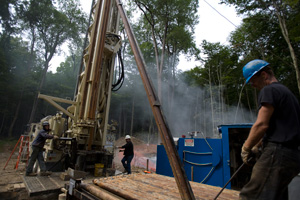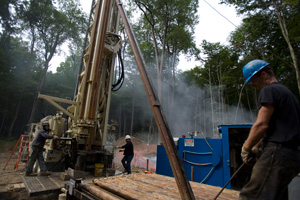 Pennsylvania environment officials are investigating another natural gas well leak, after residents near the town of Roaring Branch complained last month that rust-colored water was flowing from a spring and two small creeks were bubbling with methane gas.
Pennsylvania environment officials are investigating another natural gas well leak, after residents near the town of Roaring Branch complained last month that rust-colored water was flowing from a spring and two small creeks were bubbling with methane gas.
The incident is the latest in a string of more than 50 similar cases related to gas drilling in the state, and comes as ProPublica published an article last week reporting that such events were more frequent than officials said.
According to the Department of Environmental Protection, at least four homes in the rural north-central part of Lycoming County are now being supplied with drinking water and 18 are having their water tested or their homes monitored for gas while the investigation continues. At least one woman was temporarily evacuated from her home last week as a precaution, according to Robert Yowell, north-central regional director for the DEP’s oil and gas bureau.
Officials suspect that a well casing on one of three natural gas wells drilled by East Resources failed, allowing the gas to migrate into the ground and the streams, according to Yowell and a statement e-mailed to ProPublica from DEP headquarters. The wells were drilled into the Oriskany geologic formation, not the Marcellus shale, where much of the state’s new development is targeted. The department is analyzing water and gas samples and has promised to post the results on the DEP Web site by the end of the week.
The well casing consists of several layers of steel pipe and concrete that surround a well structure and is intended to protect groundwater supplies from the gas and drilling fluids inside of the well. Unlike many other gas drilling states, Pennsylvania doesn’t have regulations that require this concrete and casing be tested to confirm its strength.
East Resources referred questions to its general counsel who was not immediately available for comment.
According to Yowell, the company has temporarily shut down the suspected problem well by filling it with drilling mud, a slurry of the waste produced from the drilling of the well hole, and has been working to reduce pent-up pressure inside its wells that could be forcing stray gas out of cracks in the casing. To release that pressure, East Resources flared — or burned off gas — from two of the suspected wells.
“It looked like the sky was on fire,” said Margaret Yaggie, a Roaring Branch resident who can sit on her porch and see the East Resources wells a few miles away. Yaggie said the flames stretched hundreds of feet and carried fumes and smoke. “It’s above the trees, on the side of a mountain. It looks like hell.”
It appears the measures have been effective in slowing the gas leak.
“One well that was suspect has been plugged and killed,” Yowell said, adding that the plugging dramatically reduced pressure. “The readings (of methane) around the stream have gone down. We believe things are getting under control but [they’re] certainly not abated yet.”
Though Pennsylvania has more gas wells than any state other than Texas, Lycoming County hasn’t seen such development until recently. According to Yowell, who only began to oversee oil and gas operations in April when the state established a regional headquarters to handle the rush to drill, the Roaring Branch contamination is the first of its kind in the area.
In a weekend article in the Wayne Independent, a local newspaper, East Resources spokesperson Douglas Mehan — who later referred ProPublica’s questions to the company’s attorney — was quoted as saying “the gut feeling of everybody is that this is very, very rare — a unique incident.”
ProPublica has documented a series of cases in seven other Pennsylvania counties and across the nation in which methane has leaked from natural gas drilling operations. On Friday ProPublica published an article challenging Pennsylvania officials’ claims that such cases were “an anomaly,” noting that the state has hired a full-time inspector dedicated to stray gas problems and has recorded at least 52 cases similar to the one in Lycoming County. In several instances houses exploded as a result of the gas leaks. In one case, three people were killed.
Asked whether these cases constituted a pattern, the Department of Environmental Protection official who first described methane contamination as an anomaly, Craig Lobins, told ProPublica that the number of safely drilled wells in Pennsylvania far outweigh those that cause problems. “We are just dealing with a very small percentage,” he said.



